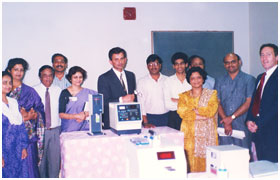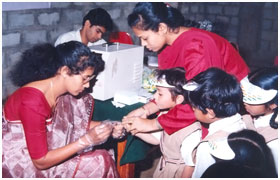 |


|
Problem of Lead Poisoning
NATIONAL REFERRAL CENTRE FOR LEAD POISONING IN INDIA
The National Referral Center for Lead Poisoning Prevention in India (NRCLPI)
established by The George Foundation with St. John's National Institute
of Health Sciences has now become the nodal referral center in India.
Several sub centers are being setup in Andhra Pradesh, Kerala and other
states. NRCLPI conducts blood tests, awareness creation efforts and consultation
with lead-based industries to reduce lead contamination.
The George Foundation, through NRCLPI, sponsored the evaluation of blood
lead levels in lead acid battery industry workers. It has provided reagents
and equipment.
OK International (USA) has come forward with an initial grant of US$
2000 to fund NRCLPI projects on lead in the environment and health. Details
of the project are being worked out. NRCLPI has initiated a global networking
effort to limit childhood lead poisoning. A nodal centre has been established
in Mauritius with the help of its government. The centre will evaluate
lead-related health problems in the African subcontinent.
In India, the state governments of Andhra Pradesh, West Bengal and Tamil
Nadu are supporting the establishment of state-level referral centres
for lead absorption as Chapters of NRCLPI.
A proposal for preparing a lead map of India and a project for a museum
of lead-based products both require financial and other support.
Karnataka State PCB has provided NRCLPI Rs.82,800 to screen children
below 12 years of age at all district headquarters. Each phase will cover
three districts at a time. Three students of Rajiv Gandhi University of
Health Sciences and one student of MAHE Manipal have registered for their
Ph.D studies on lead-based health topics in the field of Biochemistry.
In Bangalore, the Bangalore Municipal Transport Corporation is meeting
the actual expenditure incurred in screening transport employees for blood
lead. HICAL Magnetic in Electronic City on the outskirts of Bangalore
is covering the cost of evaluation of blood lead in women working in the
electronic soldering industry.
Lead poisoning is the number one environmental disease among children
in developing countries. The full impact of lead poisoning on the health
of children and adults is becoming clearer to most countries, and many
governments have begun to take action. Those countries that have developed
lead prevention programs have realized significant health and economic
benefits.
Until recently, the Government of India did not recognize the seriousness
of lead poisoning, and there was very little awareness about it on the
part of the population. However, following the blood screening of children
in major cities carried out by The George Foundation under "Project
Lead Free," this situation began to change. The accomplishments to-date
can be summarized as follows:

- During 1998-99, The George Foundation carried out blood lead tests
of over 22,000 children and adults in 7 major cities (Mumbai, Delhi,
Calcutta, Chennai, Bangalore, Hyderabad and Vellore) with the participation
of 12 hospitals in those areas. This study is the largest ever conducted
anywhere in the world to assess the level of lead poisoning in the general
population.
- In February 1999, The George Foundation sponsored and hosted in Bangalore
the largest international conference on lead poisoning prevention and
treatment ever held, jointly with the World Bank, WHO, CDC, USEPA. At
this conference, the results of Project Lead-Free were announced, that
revealed that over 51% of the children below the age of 12 living in
major urban areas of India had unacceptably elevated levels of blood
lead of 10 mcg/dl or more.
- The results of Project Lead-Free raised the concern of those involved
in medical and environmental professions, while for the first time international
agencies and the Government of India accepted the seriousness of the
problem. At the conference, the 3 major oil refining companies announced
that they would offer unleaded petrol within 15 months.
- In April 2000, all three oil companies announced the introduction
of unleaded petrol throughout India. The government regulated that all
automobiles use unleaded petrol with immediate effect.
- The George Foundation published the proceedings of the Bangalore conference,
and formed an executive committee consisting of the 5 sponsors and heads
of several Indian and international agencies to come up with a joint
resolution. This committee issued a "Call for Action" that
described what steps should be taken by developing countries to achieve
significant progress in their respective nations to reduce lead poisoning
within a 5-year timeframe.
- The Pollution Control Board within the Ministry of Environment formed
a Lead Poisoning Prevention Committee that included The George Foundation
representative as a member to formulate policy on lead poisoning prevention.
This committee accepted the "Call for Action" recommendations
with minor modifications, and subsequently issued directives through
the Ministry of Environment on battery recycling.
- The George Foundation and St. Johns Academy of Health, Bangalore, joined
together to establish the National Referral Centre for Lead Poisoning
in India (NRCLPI). This organization's primary mission is to create
public awareness about lead poisoning, assist polluting industries to
take remedial measures, and to confirm blood lead cases forwarded by
clinics/hospitals throughout the country. NRCLPI is now recognized nationally
as the pivotal institution on matters dealing with lead poisoning in
India.
- NRCLPI is currently (April 2002) conducting a major follow up study
of blood lead, lead and other additives in petrol, and the level of
harmful metals in vegetables, fruits, tap water, bottled water, milk,
house dust, play ground soil, and other sources and pathways.
More about Lead Poisoning
Lead occurs naturally in the earth's crust. When ingested, inhaled, or
absorbed through skin, lead is highly toxic to humans. Lead's toxicity
has been known for thousands of years; Greek physicians made the first
clinical description of lead poisoning in the first century B.C.
Lead is not biodegradable. It persists in the soil, in the air, in drinking
water, and in homes. It crosses all social, economical and geographical
lines. It never disappears, it only accumulates where it is deposited
and can poison generations of children and adults unless properly removed.
At high levels, lead poisoning causes coma, convulsions and death. At
low levels - levels far below those that present obvious symptoms - lead
poisoning in childhood causes reductions in IQ and attention span, reading
and learning disabilities, hyperactivity, impaired growth, behavioral
problems, and hearing loss. These effects are long-term and may be irreversible.
World-wide, six sources appear to account for most lead exposure:
- gasoline additives;
- food can soldering;
- lead-based paints;
- ceramic glazes;
- drinking water systems; and
- cosmetic and folk remedies.
Other significant exposures result from inadequately controlled industrial
emissions from such operations as lead smelters and battery recycling
plants, which contaminate environments and people in the surrounding areas.
The highest level of environmental contamination is found to be associated
with uncontrolled recycling operations and the most highly exposed adults
are those who work with lead.
Developed countries like the US, UK and Germany have taken aggressive
steps to combat lead poisoning. In developing countries, however, actions
have been slower and sporadic. Within the last decade, reports of lead
poisoning in humans have poured in particularly from the developing countries
faced with environmental and occupational lead exposure.
In India, as in most developing countries, the main source of lead pollution
is automobile exhaust. Although India issued in February 1990 its first
National Emission Standards for lead and other pollutants, the recommended
permissible limits of lead (0.56 g/L) are still very much higher than
those of developed countries like the US, UK, and Germany. In the US,
the virtual elimination of leaded gasoline resulted in a 77% decrease
in the average blood lead level of the population between 1976 and 1991.
In the UK, a 50% drop in gasoline lead levels corresponded with a 20%
drop in blood lead levels.
The scope and nature of lead poisoning that recent studies have uncovered
are alarming. Here are some hard facts:
- No level of lead in blood is safe or normal. The disturbing fact is
that exposure to extremely small amounts can have long-term and measurable
effects in children while at the same time causing no distinctive symptoms.
- Once lead is absorbed into the bloodstream, some of it is filtered out
and excreted, but the rest gets distributed to the liver, brain, kidneys
and bones.
- Lead causes anemia in both children and adults by impairing the formation
of oxygen-carrying molecules, beginning at exposures of around 40ug/dl.
In adults, small but significant increases in blood pressure result from
exposures as low as 5 ug/dl, with no evidence of a threshold below which
lead does not affect blood pressure.
- Other adverse effects in adults include kidney disease and impaired
fertility.
- Hypertension caused by lead exposure contributes to thousands of deaths
every year, particularly in men between the ages of 35 and 50.
- Children and pregnant women are particularly susceptible to lead poisoning.
- Children's digestive system absorbs up to 50% of the lead they ingest.
The high retention occurs from birth to age 6 when the brain is developing
and lead interferes with its development. By the time physical symptoms
are evident - headache, lethargy or hyperactivity, nausea, stomach aches,
vomiting, and constipation - significant brain damage has already occurred.
Abdominal pain, vomiting and constipation help greatly to differentiate
lead from infectious disease that cause similar symptoms and are common,
but result in diarrhea.
- Children pick up lead dust from the floor, from their toys and from
pets. They ingest lead when they put their hands in their mouths, when
they eat with their hands, when they suck their thumbs, when they ingest
soil. Lead compounds used in paint taste sweet, encouraging small children
to lick or chew paint chips or chalky paint residue. A single chip of
paint of the size of a thumbnail contains 1 gram of lead and a few such
chips can raise the intake of lead to 1,000 times the acceptable limit.
- Blood lead levels in children of around 10 ug/dl are associated with
disturbances in early physical and mental growth and in later intellectual
functioning and academic achievement. These persist into adulthood and
may be irreversible.
- Progressive elevation of blood lead levels in a child's system can cause
a potential genius to drop to an average achievement level and an average
child to become learning disabled. Studies have shown as much as a 5.8
decline in IQ (on a scale where 100 is average) for every 10 micrograms
increase of lead in blood levels. Long-term consumption of low levels
of lead can be more dangerous than a single ingestion of concentrated
lead.
- The fetuses of pregnant women are gravely affected by lead exposure
since lead can pass through the placenta directly into the baby. When
an expectant mother maintains a poor diet, the problem is compounded since
she will start breaking down bone to release calcium and other minerals,
thereby releasing lead stored in the bones which passes to the developing
baby. High lead exposure probably results in fetal death.
- Deficiency of iron, calcium and zinc increase absorption and effects
of lead.
- The Centers for Disease Control and Prevention (CDC), USA, has developed
various classes of elevated blood lead levels in children. If a child's
level is greater than 45 ug/dl, chelation treatment and exposure reduction
should start within 48 hours, while levels at or above 70 ug/dl are a
medical emergency. Even higher levels cause swelling of the brain or encephalopathy.
Children with levels above 120 ug/dl may die unless immediately treated.
- Childhood lead poisoning is typically more severe in developing countries
due to inadequately controlled industrial emissions, unregulated cottage
industries, and cultural practices such as folk medicines containing lead.
- The World Health Organization estimates that 15-18 million children
in developing countries are suffering from permanent brain damage due
to lead poisoning. Hundreds of millions of children and pregnant women
in practically all the developing countries are exposed to elevated levels
of lead.
|






























